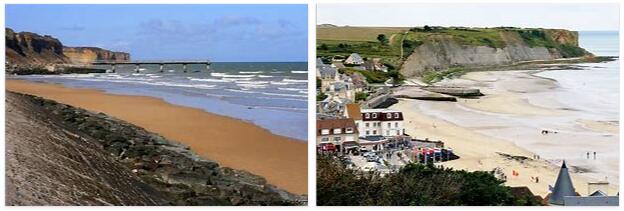Dordogne and the Lascaux cave
General information about the cave
The Lascaux Cave is about 2 km south of Montignac, on the left side of the winding river Vézère. The area is located in the French Dordogne department. It extends over an approximately 250 m long corridor system with 25 grottos and contains numerous paintings and engravings that were made tens of thousands of years ago. Numerous animal species were depicted, including lions, reindeer and horses. Most impressive is probably the 5.2 meter high figure of a bull, which became the symbol of the Dordogne. The Lascaux cave has been a registered attraction and part of the UNESCO World Heritage Site since 1979. The works of art to be found there are among the oldest works of fine art that have remained with mankind to this day.
About history
The ancient paintings were discovered by a few youngsters from Montignac, of all people. Just a few weeks after this discovery, the first scientists came to search the old cave. However, the public was not allowed to set foot in the cave for the first few years. It was not opened to general tourism until 1948. Even during the time of tourism, researchers kept coming there who wanted to go in search of ancient relics. In 1949, decorated spearheads were recovered. For a better overview and a simplification of the scientific work, numerous copies of the paintings were made between 1952 and 1963. Almost 2,000 pieces have been completed to date.
The onset of tourism showed its downsides after a few years. Despite various safety precautions, something happened that the scientists hadn’t expected: the paintings gradually lost their quality. Due to the large numbers of visitors of over a thousand people a day, the climate in the cave changed. The air has been enriched with condensation water and organic substances from the air people breathe. This led to mold growth, which could only be contained by keeping the public at a distance again. In 1963 the Lascaux cave was closed. The core rooms are still not allowed to be entered.
Measures have of course been taken for the further influx of interested study travelers. For this reason, Lascaux II was created, a museum located near the original, in which, among other things, the room of the bulls was reproduced in great detail. During the creation of the work, care was taken to use the same techniques and colors in order to obtain a copy that was as realistic as possible.
D-Day Beaches in Normandy
Allied landing beaches
On June 6, 1944, one of the decisive operations of the Second World War began: on this so-called “D-Day” the western allies landed on the French coast, in Normandy west of Caen in the department of La Manche. Mostly Americans, British and Canadians were involved. Many factors played a role in ensuring that “Operation Overlord”, as the operation was also called, turned out well for the Allies: The weather played along, the plans were kept secret from the enemy, and the Western Allies worked together successfully. A detour to the beaches of Normandy, where the dramatic events took place, can turn into a study trip into contemporary history. For all tourists interested in history, it is worthwhile
Omaha Beach and Utah Beach
The Allies divided the coastal region where the invasion was to take place into different sections. Two of the most famous stretches of coastline are Omaha Beach and Utah Beach. Omaha Beach is around ten kilometers long. Landing there was particularly difficult because the cliffs sloped steeply towards the sea. As a result, the Americans lost around 3,000 people on the first day of the invasion. It makes a deep impression on the visitor to walk along this beach above the cliffs. Utah Beach is about three miles long and was easier to take. The “Museum Utah Beach” shows memorabilia from D-Day, for example an airplane. The “Battery of Azeulle” can also be visited. It is a fortress, part of the Atlantic Wall that the Allies had to overcome. There are numerous military cemeteries and memorials in the hinterland of the D-Day beaches. Examples are the chapel of Saint-Lo (a memorial to the American soldiers) and the German military cemetery in Orglandes.
Sainte-Mère-Eglise
South of Cherbourg, about seven kilometers from the coast, is the town of Sainte-Mère-Eglise, the first French commune to be liberated by the Allies. The “Airborne Museum” in Sainte-Mère-Eglise recalls the events of the D-Day. The bell tower of the village church is a popular photo opportunity. A parachutist got caught on this tower on D-Day and was only rescued after a few hours.
Giverny
The French community is world famous primarily for the former home and garden of Claude Monet. The idyllically located 500-inhabitant village in the Seine Valley in northern Normandy, where the famous painter lived with his family from 1883 until his death in 1926, should not be missed on any trip to the region. For several years now, both the house and the adjoining garden, which is well worth seeing, have been registered as historical monuments.
Monet’s home and museum of impressionisms
At the end of the 19th century, Claude Monet laid out a very attractive garden around the house with a large pond and many exotic plants, which he used as inspiration for numerous paintings. Both the house with the pink facade, the yellow dining room and the blue kitchen as well as the garden can still be visited today. Thousands of visitors from all over the world take advantage of this opportunity every year. Not far away is the Museum of Impressionisms. Here visitors get an insight into the development and diversity of impressionism. Two different temporary exhibitions take place here every year. Also not to be missed in Giverny is the Romanesque church of Sainte-Radegonde from the 11th century, which is well worth seeing. There is a cemetery right next to the church.
